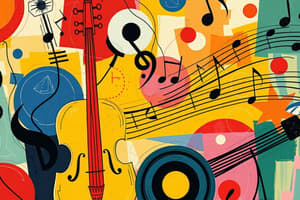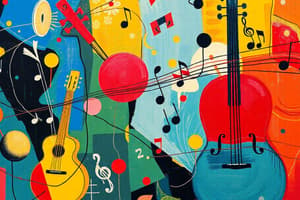Podcast
Questions and Answers
Which term refers to the speed of the beat in music?
Which term refers to the speed of the beat in music?
- Tempo (correct)
- Duration
- Meter
- Syncopation
Rhythm can exist without melody, but melody cannot exist without rhythm.
Rhythm can exist without melody, but melody cannot exist without rhythm.
True (A)
What is syncopation in music?
What is syncopation in music?
An 'off-the-beat' accent.
The term __________ describes a gradually slowing down of the tempo.
The term __________ describes a gradually slowing down of the tempo.
Match the following tempo indications with their meanings:
Match the following tempo indications with their meanings:
What term describes a smooth and easy-to-sing melody?
What term describes a smooth and easy-to-sing melody?
Dissonance refers to a smooth-sounding harmonic combination.
Dissonance refers to a smooth-sounding harmonic combination.
What is the art of combining pitches into chords called?
What is the art of combining pitches into chords called?
Harmony that avoids any sense of a 'home' key center is called ____.
Harmony that avoids any sense of a 'home' key center is called ____.
Match the type of harmony with its description:
Match the type of harmony with its description:
Which term refers to the unique characteristics produced by a singer or instrument?
Which term refers to the unique characteristics produced by a singer or instrument?
Monophonic texture features multiple independent melodies played simultaneously.
Monophonic texture features multiple independent melodies played simultaneously.
What are the three classifications of musical texture?
What are the three classifications of musical texture?
A piece of music featuring multiple independent melodies is classified as ________ texture.
A piece of music featuring multiple independent melodies is classified as ________ texture.
Match the following textures with their descriptions:
Match the following textures with their descriptions:
Which of the following best describes imitative texture?
Which of the following best describes imitative texture?
Imitative texture is primarily found in monophonic music.
Imitative texture is primarily found in monophonic music.
Name one type of musical form that involves repetition of the same music for different verses.
Name one type of musical form that involves repetition of the same music for different verses.
What is the beat value of a quarter note?
What is the beat value of a quarter note?
A crescendo indicates a sudden change in volume to a louder sound.
A crescendo indicates a sudden change in volume to a louder sound.
A two-part musical form where both sections are repeated is known as ___ form.
A two-part musical form where both sections are repeated is known as ___ form.
Match the musical forms to their descriptions:
Match the musical forms to their descriptions:
What is the Italian term for 'very quiet' in dynamics?
What is the Italian term for 'very quiet' in dynamics?
A whole note is equal to _____ beats.
A whole note is equal to _____ beats.
Match the following musical terms with their meanings:
Match the following musical terms with their meanings:
Flashcards are hidden until you start studying
Study Notes
Music Characteristics, Styles, and Movements
- Rhythm serves as the structure and pulse of music, encompassing duration, tempo, and meter.
- Rhythm exists independently of melody; however, melody relies on rhythm for its formation.
- Duration refers to the length of sounds or silences, while tempo indicates the speed of beats.
- Common Italian tempo terms include:
- Largo (slow)
- Adagio (slow)
- Andante (steady)
- Moderato (moderate)
- Allegro (fast)
- Presto (very fast)
- Syncopation introduces accents on the off-beat, creating patterns that can enhance musical expression.
- Gradual tempo changes can occur through:
- Ritardando (slowing down)
- Accelerando (speeding up)
- Rubato (expressive tempo variations often found in Romantic music)
Melody and Harmony
- Melody can be classified as conjunct (smooth and easy) or disjunct (jumpy and difficult).
- Harmony contrasts with melody, focusing on pitch combination to form chords and progressions.
- Terms to describe harmony:
- Dissonance denotes harsh-sounding combinations.
- Consonance suggests smooth-sounding combinations.
- Different harmony types include:
- Modality, based on medieval and Renaissance modes.
- Tonality, centered around a "home" key.
- Atonality, avoiding a definitive key center.
Texture and Musical Form
- Imitative texture occurs when musical ideas are echoed across voices, prevalent in polyphonic music.
- Musical form organizes melodic, harmonic, and rhythmic elements, with common structures being:
- Strophic Form: identical music for various verses (e.g., "Deck the Halls").
- Binary Form: two contrasting sections, each repeated.
- Ternary Form: three sections with a return of the initial music after contrast.
Tone Color and Dynamics
- Tone color, or timbre, refers to unique sound characteristics made by singers or instruments.
- Musical texture can be categorized as:
- Monophonic: single, unaccompanied lines.
- Homophonic: multiple notes supporting a prominent melody.
- Polyphonic: independent melodies sounding simultaneously with complex interrelations.
- Note values indicate duration in beats:
- Whole note (4 beats), Half note (2 beats), Quarter note (1 beat), Eighth note (1/2 beat), Sixteenth note (1/4 beat).
- Rest values mirror note values in duration.
Dynamics
- Dynamics relate to the loudness or softness of music with terms often drawn from Italian.
- Important dynamics terms include:
- Pianissimo (PP) = very quiet
- Piano (P) = quiet
- Mezzo-piano (Mp) = moderately quiet
- Mezzo-forte (Mf) = moderately loud
- Forte (f) = loud
- Fortissimo (ff) = very loud
- Dynamic changes can be indicated by:
- Crescendo (gradually louder)
- Diminuendo (or decrescendo, gradually quieter)
- Accent (emphasizing a note).
Studying That Suits You
Use AI to generate personalized quizzes and flashcards to suit your learning preferences.




